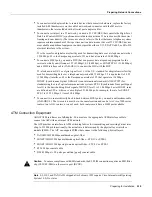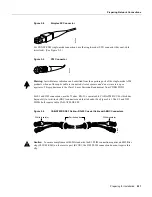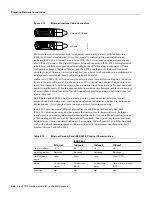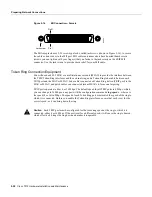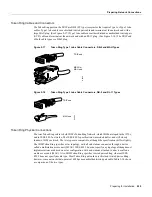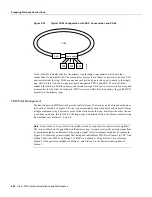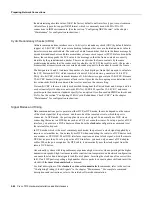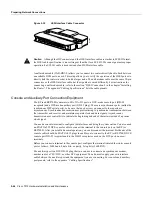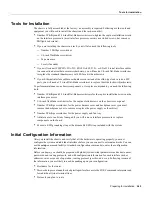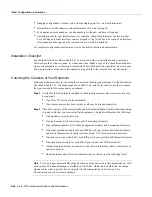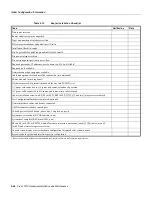
Preparing for Installation 2-33
Preparing Network Connections
FDDI Transceivers and Cable Connectors
The FIP single-mode interface uses simplex FC-type connectors for the Transmit and Receive ports.
(See Figure 2-20.) The connector accepts standard 8.7 to 10/125-micron single-mode fiber-optic
cable. The single-mode interface supports connections at distances up to 6 miles (10 kilometers).
Figure 2-20
Single-Mode FDDI Network Interface Connectors, FC Type
The multimode transceiver supports distances of up to 1.2 miles (1.9 kilometers). The multimode
connector is an FDDI-standard physical sublayer (PHY) connector that encodes and decodes the
data into a format acceptable for fiber transmission. The multimode connector accepts standard
62.5/125-micron multimode fiber-optic cable using the media interface cable (MIC) and, with
proper cable terminators, can accept 50/125 micron fiber-optic cable. Multimode uses the integrated
MIC connector shown in Figure 2-21 at both the FIP and network ends.
Figure 2-21
Multimode FDDI Network Interface Connector, MIC Type
The multimode/multimode FIP (CX-FIP-MM) provides a control port for an optical bypass switch,
which allows the light signal to pass directly through the bypass switch and completely bypass the
FIP transceivers when the interface has failed or is shut down. Most optical bypass switches provide
the necessary interface cables for connection to the multimode MIC connectors on the FIP; however,
not all manufacturers use the same type of DIN connector for the control port. Some manufacturers
use a DIN, and some use a smaller version, a mini-DIN. The optical bypass control port on the FIP
requires a mini-DIN connector. A DIN-to-mini-DIN adapter cable (CAB-FMDD) is included with
the multimode/multimode FIP to ensure that you can connect to either type.
The FIP supports both Class A and Class B station connections and provides an interface for both
single-mode and multimode fiber-optic cable. The two physical ports (PHY A and PHY B) are
available with either single-mode (FC) or multimode (MIC) port connectors, or with a combination
of one of each for matching multimode and single-mode fiber in the same FDDI network.
FDDI Physical Connections
FDDI, which specifies a 100-Mbps, token-passing dual-ring network using fiber-optic transmission
media, is defined by the ANSI X3.1 standard and by ISO 9314, the international version of the ANSI
standard. An FDDI network comprises two token-passing fiber-optic rings: a primary ring and a
secondary ring. An FDDI ring consists of two or more point-to-point connections between adjacent
stations.
On most networks, the primary ring is used for data communication, and the secondary ring is used
as a backup. Class B, or single-attach stations (SAS), attach to one ring and are typically attached
through a concentrator; Class A, or dual-attach stations (DAS), attach to both rings. Figure 2-22
shows a typical FDDI configuration with both DAS and SASs.
H1348a
H1349a
Содержание TelePresence Server 7010
Страница 10: ...x Cisco 7010 Hardware Installation and Maintenence ...
Страница 14: ...iv Cisco 7010 Hardware Installation and Maintenance Document Conventions ...
Страница 112: ...2 52 Cisco 7010 Hardware Installation and Maintenance Initial Configuration Information Page ________ ...
Страница 148: ...3 36 Cisco 7010 Hardware Installation and Maintenance Using the Flash Memory Card ...
Страница 158: ...4 10 Cisco 7010 Hardware Installation and Maintenance Troubleshooting the Processor Subsystem ...
Страница 242: ...5 84 Cisco 7010 Hardware Installation and Maintenance Replacing Internal Components ...
Страница 258: ...A 16 Cisco 7010 Hardware Installation and Maintenance MIP Interface Cable Pinouts ...
Страница 270: ...B 12 Cisco 7010 Hardware Installation and Maintenance Interface Processor LEDs ...
Страница 274: ...C 4 Cisco 7000 Hardware Installation and Maintenance ...
Страница 287: ...Index 13 ...

